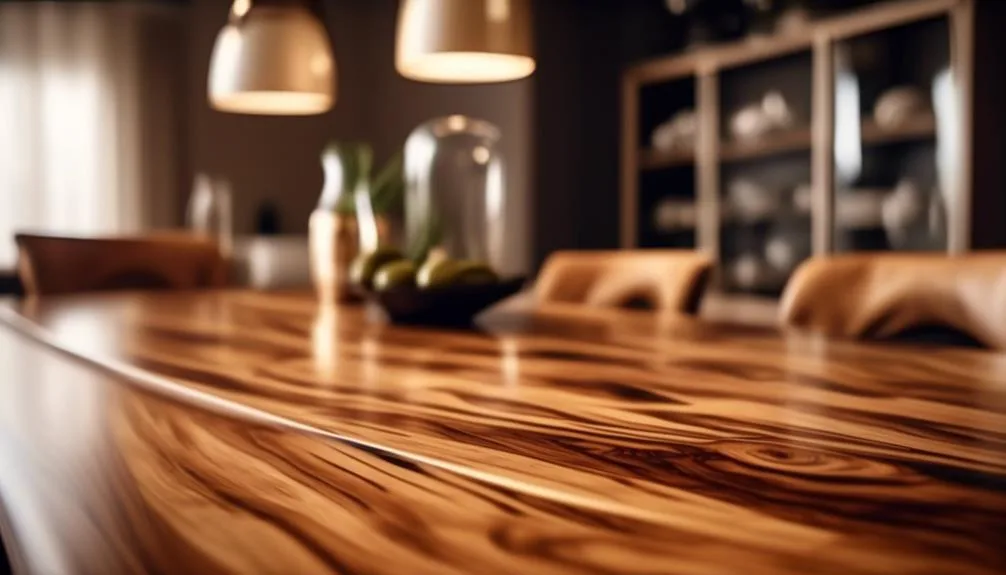If you're thinking about getting an olive wood dining table for your home, you might be wondering if it's a sustainable choice. As more people look for eco-friendly furniture, it's important to know the environmental impact of different materials.
Let's take a closer look at olive wood and its suitability for making furniture. We'll explore where it comes from and the rules around harvesting it.
Key Takeaways
- Olive wood is a sustainable choice for furniture due to its ethical sourcing practices and repurposing of non-productive trees.
- Olive wood furniture has a minimal environmental impact, with lower emissions during production and reduced waste due to its durability.
- The longevity and durability of olive wood furniture make it a long-lasting and eco-conscious option for sustainable interior design.
- Harvesting practices and regulations ensure the health of olive groves and the long-term sustainability of olive wood resources.
Olive Wood: Source and Sustainability
When considering the source and sustainability of olive wood, it's important to understand its impact on the environment and the long-term viability of its production.
Olive wood is primarily sourced from olive trees that no longer bear fruit, making it a sustainable and eco-friendly choice for furniture. Ethical sourcing practices ensure that the wood is harvested in a way that promotes the health and growth of olive tree populations. By utilizing wood from non-productive trees, the ecological balance of olive groves is maintained.
This approach also reduces waste and supports the circular economy by repurposing a natural byproduct of olive cultivation. Choosing olive wood furniture crafted from ethically sourced materials not only adds a touch of natural beauty to your home but also aligns with environmentally conscious consumer choices.
Environmental Impact of Olive Wood Furniture
Considering the environmental impact of olive wood furniture, it's essential to understand its contribution to sustainable practices and the preservation of natural resources.
When it comes to the carbon footprint, production of olive wood furniture involves minimal processing, leading to lower emissions compared to other materials.
The eco-friendly nature of olive wood furniture also lies in its durability, which reduces the need for frequent replacements and minimizes waste.
Additionally, the use of olive wood provides an alternative to other more resource-intensive woods, promoting sustainable forestry practices.
Moreover, the longevity of olive wood furniture means less consumption and disposal, further lessening its environmental impact.
These factors collectively position olive wood furniture as a viable and eco-conscious choice for sustainable interior design.
Longevity and Durability of Olive Wood
The longevity and durability of olive wood furniture make it a compelling choice for sustainable interior design, offering both aesthetic appeal and environmental benefits.
Olive wood is renowned for its exceptional longevity, often lasting for generations with proper care. Its dense and strong nature contributes to its durability, making it resistant to wear and tear.
With minimal maintenance requirements, such as periodic oiling to preserve its natural luster and prevent drying, olive wood furniture can maintain its beauty for many years. Its resilience to moisture and pests further enhances its longevity, ensuring that it remains a timeless and sustainable choice for furniture.
Harvesting Practices and Regulations
With its exceptional longevity and durability in mind, it's important to understand the harvesting practices and regulations that ensure the sustainability of olive wood furniture.
- Harvesting Practices:
- Olive wood is typically harvested from pruned branches and trees that no longer produce fruit, ensuring minimal impact on olive orchards.
- Sustainable harvesting methods involve careful selection of trees and branches to maintain the health of the olive groves.
- Sustainability Regulations:
- Many olive wood harvesting operations adhere to strict regulations to protect the environment and ensure the long-term sustainability of olive wood resources.
- Some regions have specific laws in place to control the harvesting and export of olive wood, preventing overexploitation and illegal logging.
Understanding these harvesting practices and regulations is crucial in ensuring that the production of olive wood furniture remains environmentally sustainable.
Comparing Olive Wood Sustainability to Other Wood Types
In evaluating the sustainability of olive wood furniture in comparison to other wood types, it becomes evident that its unique harvest practices and regulations set it apart. When comparing olive wood to other common wood types, such as oak, pine, teak, and mahogany, its environmental benefits become clear.
| Wood Type | Sustainability | Environmental Benefits |
|---|---|---|
| Olive Wood | High | Drought-resistant trees, limited water usage, no chemical treatments |
| Oak | Moderate | Slow growth, high water usage, often treated with chemicals |
| Pine | Low | Fast growth, high water usage, often sourced from unsustainable forests |
| Teak | Moderate | Slow growth, high water usage, vulnerable to deforestation |
| Mahogany | Low | Slow growth, high water usage, vulnerable to deforestation |
Olive wood stands out due to its drought-resistant nature, limited water usage, and absence of chemical treatments, making it a sustainable and eco-friendly choice for furniture.
Conclusion
Considering its renewable source, minimal environmental impact, and long-lasting durability, olive wood emerges as a responsible choice for furniture.
With regulated harvesting practices, it stands out as an eco-friendly option.
Next time you shop for furniture, reflect on the positive impact olive wood can have on the environment.

